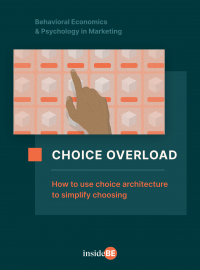How to Use Simple Messaging to Build Brand Trust

In this article, you’ll discover:
- How simple messaging increases brand trust;
- What the 27-9-3 rule is and how it’ll help you craft better messages; and
- How “decision simplicity” creates an opportunity to cultivate consumer relationships.
“The simplest explanation is usually the correct one.” – Ockham’s Razor
In the 14th Century, William of Ockham once said that simplicity is better than complexity when solving problems. Centuries later, market research supports Ockham’s Razor argument when it comes to building brand trust. According to Harvard Business Review’s article, “To Keep Your Customers, Keep It Simple,” if you speak in simple language, consumers are more likely to trust your brand.
Trustworthy Advertising
A simplified, overarching message is often the objective of creative briefs for advertising campaigns. However, brand managers don’t always see simplicity as equating to trust. Managers may have developed easy-to-grasp messaging to promote the product or service, but simultaneously work hard to develop reliability by using complicated language to reflect brand expertise. These efforts are often working against each other.
An excellent example of counterproductive marketing is presented in a case study discussed by Simon Moore of Innovationbubble about a bank. The marketing effort involved the bank developing a campaign to establish greater trust with customers.
To change customer behavior, their communications cited historical facts and figures about the bank that were self-serving and not necessarily easy for customers to appreciate. The campaign failed and there was a need for a change in strategy.

Discover ground-breaking ideas and fascinating solutions.
To change perceptions, a fresh round of market research was conducted that applied behavioral science insight to understand customer’s unconscious attitudes. What researchers discovered was that it’s not that people don’t trust banks, but that people don’t trust themselves to manage their own money!
An effective campaign was created to provide accessible tutorials to teach customers how to bank more efficiently. The new messaging helped to move the market share needle back in their favor.
What researchers discovered was that it’s not that people don’t trust banks, but that people don’t trust themselves to manage their own money!
Tactical Approaches
One form of communication that supports the relationship between simplicity and trust is the user experience on a website. If your design requires multiple steps to find general information, or the language isn’t presented in a logical sequence, this can undermine consumer confidence.
This is why UX design is so crucial. It provides consumers with a positive experience and helps them determine what brands they trust and return to overtime. A fitting quote by UX designer Frank Chimero sums up the necessity of this tactical approach: “People ignore design that ignores people.”
“People ignore design that ignores people.”
Aligned with this idea of presenting simple, trustworthy communications comes from the perspective of cognitive science. There’s a principle that discusses the use of simple tactics to communicate messages. The concept is known as “cognitive load.”
People have a limited amount of attention and memory. If the images used or the size of the font takes too long to process, you may lose consumers or an opportunity to communicate a message. An elegant example of this is the 27-9-3 rule. Research has shown that the human brain can effectively process no more than 27 words that can be spoken in 9 seconds and that have 3 (or fewer) pieces of information.
This approach was used by the American Water Works Association in April 2020 early on during the COVID-19 pandemic. AWWA hosted a webinar on how utilities can be a trusted source of information. Following a communications plan and using a spokesperson, it was revealed that water utilities should focus on simple messages that use basic terminology to demonstrate their reliability.
Decision Simplicity
The HBR article mentioned earlier highlighted that one of the most important factors involving securing purchases is decision simplicity. This concept can be demonstrated by reviewing two approaches to selling cameras to web searchers.
One website provides visitors access to extensive information about each of its products, requiring users to walk through different parts of the website to get more information.
The second firm, on the other hand, focuses on the user’s needs and directs the consumer to the best product based on how the user interacted with the website. The article explained how the second approach would be far more successful in today’s marketplace.
The easier a brand makes the purchase-decision journey, the higher its decision-simplicity score.”
To demonstrate the idea of decision simplicity, the researchers conducted a study leveraging a ‘decision simplicity index’ – the ease with which consumers can gather trustworthy information about a product and confidently and efficiently weigh their purchase options. The easier a brand makes the purchase-decision journey, the higher its decision-simplicity score.”
Brands that scored in the top quarter of the study were 9% more likely to purchase a product again in the future and 115% more likely to recommend it than the brands in the bottom quarter of the index.
Going to the Source
A core component of trusting a simple message is how people feel about its source. A classic study in psychology showed that when personal relevance for a message was minimal, its persuasiveness was based on the trustworthiness of the source. Alternatively, the higher the personal relevance of a message, the persuasiveness was more about the power of the message than the source.
When the consumer is unfamiliar with a product or service, simply communicated messages that reflect personal relevance can work to influence consumer perceptions of a brand’s trustworthiness.
Simplicity = Trust
There are many factors that come into play when attracting and maintaining customers; whether that’s in the private or public sector. Trust is without a doubt a factor that has proven to grow customer relationships over time. While there are many ways to build trust, research shows an effective approach you can take is to speak simply.
All in all, the language you use, the strategy and tactics you coordinate, and the steps you present to customers are critical to a successful messaging campaign that works to build trust.
Key Takeaways
- Communications expressed in simple language (layman’s terms) can help convince consumers that a brand is trustworthy. This idea is reflected in crisis communications, marketing campaigns, and public works efforts.
- Considering how the brain processes information can work to boost the effectiveness of communications. Cognitive research supports the concept of the 27-9-3 rule to provide a framework for effective messaging.
- The marketing strategies and tactics employed should be aligned so that decision simplicity is prioritized. Market research shows that brands that offer an easy path to a purchase decision are more likely to result in a sale.






